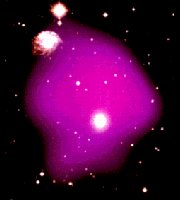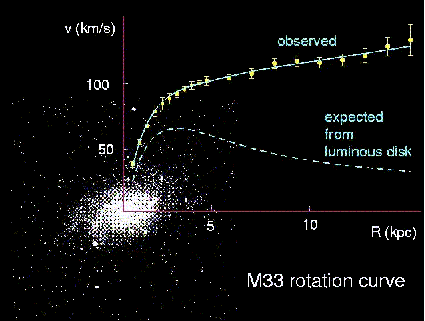How do we know it exists?
There are many experimental
evidences to support the existence in the Universe of
dark matter.
![]() .
.
- Motion of stars in a galaxy. Spiral galaxies
have a central nucleus full of stars and spiral arms wrapped around the nucleus, which follow the rotational
direction of the entire structure. Each star belonging to the galaxy rotates at its own speed around the centre.
From simple considerations , we expect that, at great distances from
the galactic centre (so great that the galaxy can be considered an enormous concentrated mass), the tangential
speed of a star should decrease as the distance increases.
We see a similar situation regarding speed and distance with the planets of the solar system: planets nearer the sun are faster than those further away.
Fig. 1 shows values measured for the tangential speeds of the stars around the centre of the galaxy M33 (yellow dots), in relation to their distance from the centre. There is a steady increase in speed, not a decrease as expected (dotted line).
The most likely explanation for the higher speed of the external stars assumes the presence of non-visible matter in the halo of each galaxy, including our own, the Milky Way.
Fig. 1: Tangential speed of stars in the galaxy M33, depending on their distance from the centre. Points with error bands are experimental measurements; the curve is traced to give the best reproduction of the dependence of speed. The dotted line shows the decrease in speed expected for the relatively few stars found at distances greater than the average size of the galaxy. To show this more clearly, the optical image of the galaxy has been placed over the graph.
- Motion of galaxies in large clusters.
Clusters
 of galaxies are groups of galaxies. As already mentioned with regard to the first proof
of dark matter, if we calculate the amount of mass in the cluster from the
motion of the galaxies within the cluster, we find that, if the mass
consists only of the observable mass, the gravitational force would not be sufficient to prevent the galaxies escaping from
the cluster. This makes us think that there is further dark matter amidst the galaxies of a cluster.
of galaxies are groups of galaxies. As already mentioned with regard to the first proof
of dark matter, if we calculate the amount of mass in the cluster from the
motion of the galaxies within the cluster, we find that, if the mass
consists only of the observable mass, the gravitational force would not be sufficient to prevent the galaxies escaping from
the cluster. This makes us think that there is further dark matter amidst the galaxies of a cluster.
- Presence of gas clouds in the outermost parts of the galaxies and in the space between galaxies. Studies of the outer boundaries of galaxies where there are very few stars and therefore negligible visible light from stars have shown enormous gas clouds confined in the cluster (Fig. 2). In order to explain why these clouds are not dispersed in space, we must suppose the existence of dark matter, distributed in a different way from that deduced only from the visible component. Could there also be galaxies of dark matter? From recent studies, it seems that the visible gaseous material in the form of halos extends well beyond the boundaries of the visible galaxies. In order to be seen, a gas must be heated. Who or what is heating it?
 |
Fig. 2:
X-rays
(Credit:Dr. R.Mushotzky Nasa Goddard Space Flight Center) |
In conclusion, there are strong indications in favour of the existence of a lot of dark matter in halos around each galaxy and amongst the galaxies of a cluster.
|
|
(How do we know … - page 1 of 2)
| Next > |

